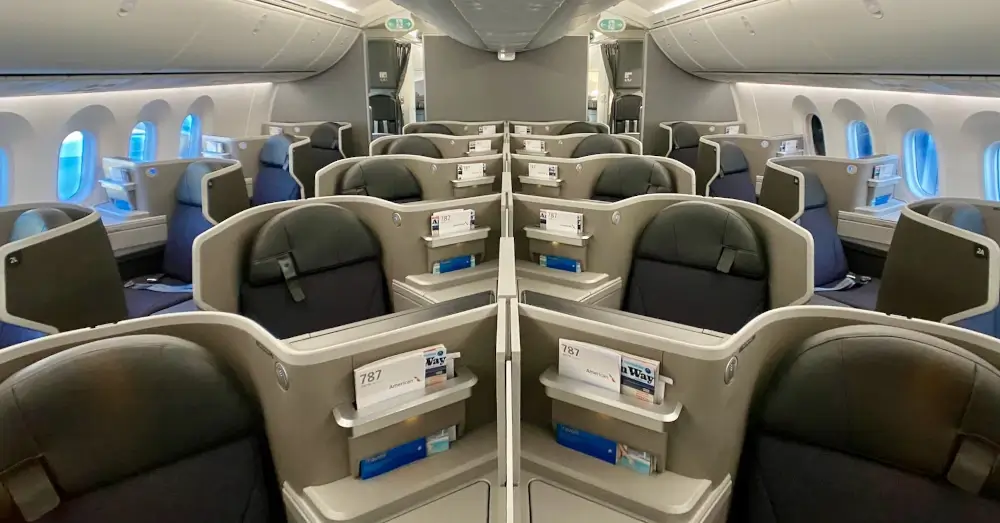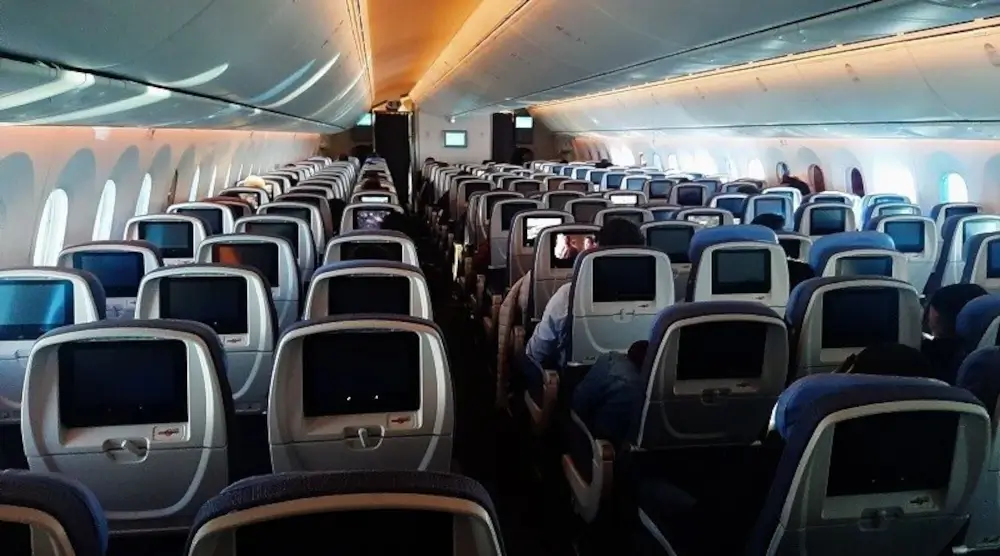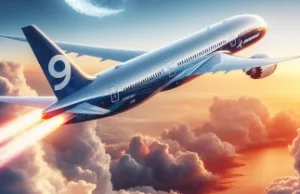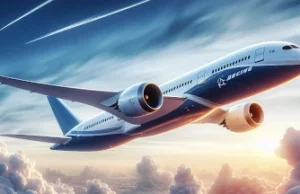About the Boeing 787 Family
The Boeing 787 Dreamliner marks a transformative advancement in the sector of large, dual-engine jets, led by the renowned U.S. company, Boeing. This series of jets is crafted to carry a diverse number of passengers, offering seating for 250 to 330 people across its various versions. This capacity situates the 787 Dreamliner in a league akin to the Boeing 767, mirroring it in both seating capacity and travel distance. Yet, the Dreamliner sets itself apart with a remarkable improvement in fuel economy over its forerunners, signifying a major triumph in the field of aeronautical engineering.
A revolutionary feature of the Boeing 787’s architecture is its trailblazing adoption of composite materials, an unprecedented move for Boeing’s commercial planes. This avant-garde method of building not only diminishes the plane’s total mass but also bolsters its fuel economy and operational range. Initially revealed to the public as the 7E7, the Dreamliner’s developmental journey reached its zenith with a ceremonial presentation at Boeing’s Everett site in Washington on July 8, 2007.
Despite facing a succession of developmental challenges that postponed its introduction, the 787 Boeing Dreamliner triumphantly executed its initial flight on December 15, 2009. This event set the stage for its first commercial flight on October 26, 2011, heralding the start of a novel chapter in aviation history. By April 2021, the assembly of the B787 family had hit a noteworthy benchmark, with the construction of over 1,000 aircraft, emphasizing its broad endorsement and the critical function it serves in uniting the globe.
Development History of the B787
The development saga of the Boeing Dreamliner 787 is a chronicle of aeronautical breakthroughs, initiated with the goal to revolutionize commercial air travel. This narrative of creativity and determination took flight in the early 2000s, as Boeing embarked on the critical mission to engineer an aircraft that would redefine the future of commercial flights. The Dreamliner’s story is one of surmounting adversities, embracing cutting-edge technologies, and establishing new industry benchmarks.
The genesis of the 787 Boeing endeavor can be linked to the cessation of the Sonic Cruiser project. With a strategic pivot from velocity to efficiency, Boeing proclaimed the inception of the 787 program, initially dubbed the 7E7 project, on April 26, 2004. This signaled the launch of a bold quest to forge an aircraft renowned for its fuel economy, passenger satisfaction, and eco-friendliness, drawing upon the knowledge and breakthroughs from the Sonic Cruiser.
The metamorphosis from blueprint to actuality gained momentum when Boeing, on January 28, 2005, bestowed the official moniker of Boeing 787 Dreamliner upon the venture. The subsequent endorsement of the Dreamliner’s blueprint underscored Boeing’s dedication to materialize this visionary jet. The 787 was envisioned not merely as an aircraft but as a precursor to a novel epoch in aviation, heralding substantial progress in composite material utilization, aerodynamic design, and propulsion systems.
Despite the initial fervor, the voyage to the Dreamliner’s inaugural ascent was laden with unexpected impediments. The original timeline, ambitiously set for 2007, was confronted with logistical hurdles and supply chain delays that hindered the arrival of crucial parts. These complications led to a sequence of deferrals, ultimately rescheduling the first flight to December 15, 2009. This ascent, a pivotal moment in aviation lore, represented the fruition of years of unwavering dedication and synergy among Boeing’s international allies.

The ensuing chapter in the Dreamliner’s odyssey was distinguished by stringent trials and certification efforts. Memorable achievements included its showcase at global airshows and a series of pivotal test flights, notably a transoceanic journey to Tokyo in July 2011. These evaluations were vital in affirming the 787’s preparedness for commercial operations, culminating with the FAA’s endorsement in August 2011.
The handover of the inaugural Boeing 787 to All Nippon Airways on September 25, 2011, signified the shift from developmental stages to commercial utilization. The Dreamliner’s maiden commercial voyage on October 26, 2011, inaugurated a fresh chapter in aviation, delivering to travelers unparalleled levels of efficiency and luxury.
The narrative of the Dreamliner further evolved with the debut and ratification of the 787-9 variant, broadening the 787 lineage and cementing Boeing’s aspiration for a more interconnected and eco-conscious world.
As the Boeing Dreamliner 787 continues its ascent in the heavens, its developmental chronicle stands as a tribute to the essence of human resourcefulness, cooperative spirit, and the unyielding quest for innovation. With an excess of a thousand orders by April 2019, the Dreamliner has not only reshaped the contours of commercial aviation but also established a new paradigm of aerial possibilities.
Boeing 787 Design
The Boeing Dreamliner 787 is a marvel of modern aviation, showcasing a low-wing monoplane configuration with elegantly swept wings and a solitary vertical tail fin. It is propelled by a duo of turbofan engines.
In a bold stride forward, the 787 incorporates carbon-fiber-reinforced polymer for half of its primary structure, a stark contrast to the 9% in its antecedent, the 777. This judicious selection of materials not only trims down the aircraft’s heft but also fortifies its structural soundness, yielding unmatched efficacy and resilience.
The core of its propulsion is the GEnx engine from General Electric, lauded for its hushed performance and stellar fuel efficiency. The engine’s construction, featuring composite materials for the nacelle and fan blades, ensures cooler operation and fewer emissions, thus bolstering fuel economy and ecological friendliness.
The 787’s state-of-the-art variable camber wings enhance lift by 2% over the Boeing 767, thanks to their ingenious design. These wings are equipped with sophisticated deflection mechanisms that operate during flight and testing, offering superior stability and maneuverability under various flight conditions.
To meet the demands of contemporary travel, the 787 Boeing features an expansive baggage hold, providing 45% more volume than its forerunner. This, along with a flat-bottomed fuselage, responds to the evolving needs of passengers, elevating the travel experience.

Cockpit
In the cockpit, the Boeing 787 pioneers new frontiers with cutting-edge projection displays that augment visibility and situational awareness. Its electronic flight plan system delivers instantaneous navigational updates, streamlining flight management and bolstering safety throughout the voyage.
The aircraft’s nose is outfitted with sophisticated sensors for turbulence detection, which autonomously fine-tune the control surfaces to mitigate discomfort and ensure a smoother ride, even under turbulent skies.
The 787’s operational efficacy is further amplified by an automated diagnostic system that leverages real-time broadband communication to enable proactive maintenance. This system transmits essential data to ground services, curtailing downtime and facilitating uninterrupted operations.
Boeing 787 Interiors
The cabin of the Boeing 787 Dreamliner offers unparalleled comfort and accessibility, with broad aisles and enhanced restroom facilities addressing the varied requirements of travelers. Features like adjustable dividers for wheelchair access and capacious overhead bins add to the convenience and comfort.
Bathed in the glow of the largest windows in commercial aviation, the cabin exudes a welcoming and roomy ambiance. Passengers can tailor their window shade settings using electrochromic technology, adding to the comfort and customization of the journey.
With advanced wireless and satellite internet capabilities, passengers enjoy uninterrupted access to entertainment and communication throughout their flight.
Every detail of the Boeing 787 interiors is thoughtfully curated to enhance the passenger experience. From the ergonomically designed seats with adjustable headrests to the mood lighting that adapts to different phases of the flight, every element is designed with passenger comfort in mind.
In collaboration with NASA, Boeing has integrated innovative engine nacelle designs with serrated edges, known as “chevrons,” to diminish noise both inside and outside the cabin. These advancements contribute to a tranquil and agreeable flight experience for all on board.
Boeing 787 Modifications
Boeing 787, with exceptional flexibility and innovative features, offers a variety of modifications, providing airlines with customized solutions for their unique needs.

787 Boeing Specifications
| 787-8 | 787-9 | 787-10 | |
|---|---|---|---|
| Capacity, persons: | 242 | 290 | 330 |
| Length, m: | 56.69 | 63 | 68.27 |
| Wingspan, m: | 60.17 | ||
| Wing area, m²: | 325 | ||
| Height, m: | 17 | ||
| Empty weight, kg: | 118,000 | 126,000 | — |
| Range, km: | 13,620 | 14,140 | 11,910 |
| Cruise speed, km/h: | 902 | ||
| Max takeoff weight, kg: | 227,930 | 254,011 | |
| Engines: | 2×General Electric GEnx-1B or 2×Rolls-Royce Trent 1000 | ||
Boeing 787 Seat Map
The seat map of the Boeing 787 Dreamliner varies by airline and specific aircraft variant. Some airlines may offer additional classes such as premium economy or first class.
The layout within the cabin is determined by the Boeing variant in question. For instance, the base model typically includes a combination of Boeing 787 Business Class and Economy Class cabins. Airlines have the flexibility to customize these layouts, such as adopting a 1-2-1 configuration for business class or a 2-4-2 setup for economy, or even opting for a single-class design.
Boeing 787 Business Class
In Business Class, passengers can enjoy the luxury of spacious seats that fully recline into a bed-like position. Each seat is designed as a mini-suite, laid out in an efficient herringbone pattern for maximum privacy.
The number of seats ranges from 24 to 36. Seats are arranged in a 2-2-2 configuration across the rows in the Boeing 787 Dreamliner seat map. Every seat can be transformed into a comfortable bed, providing a private and restful experience. Enhanced amenities include ample personal space, a gourmet menu, and various exclusive services.
Seats are grouped in pairs and distributed across three rows, with a spacious aisle located between rows 3 and 4, equipped with emergency exits and designated lavatories for Business Class travelers.


Economy Class
A seat count between 206 and 242, providing a standard yet comfortable travel experience with options for extra legroom seating. A 3x3x3 seat arrangement across three rows, dividing the cabin into two sections for streamlined boarding and disembarkation.
Soft seats equipped with ergonomic headrests and personal entertainment monitors on the seatbacks.
Sufficiently sized overhead bins ensure convenient luggage storage, allowing passengers to store their carry-on items easily and maintain a clutter-free space.




